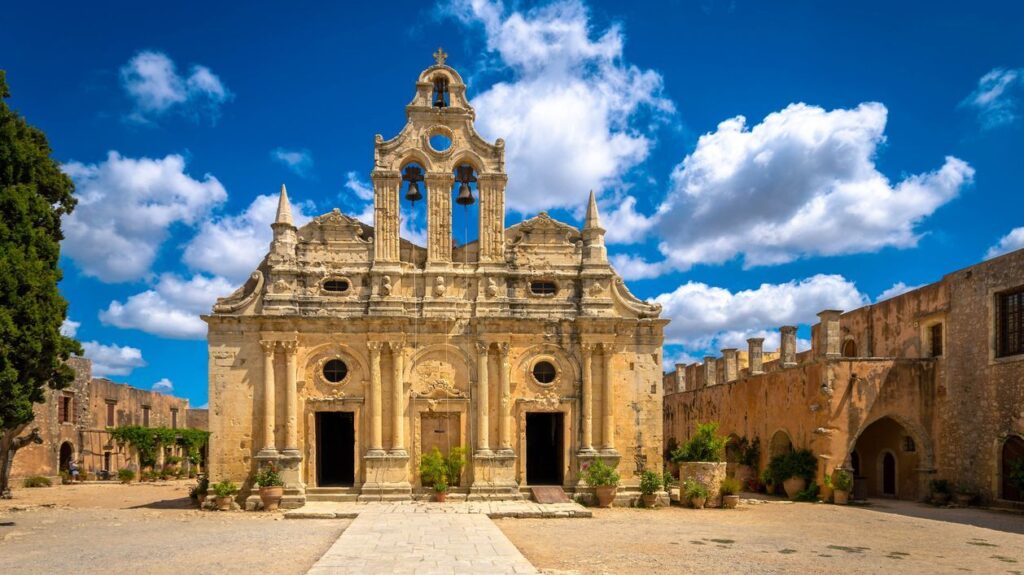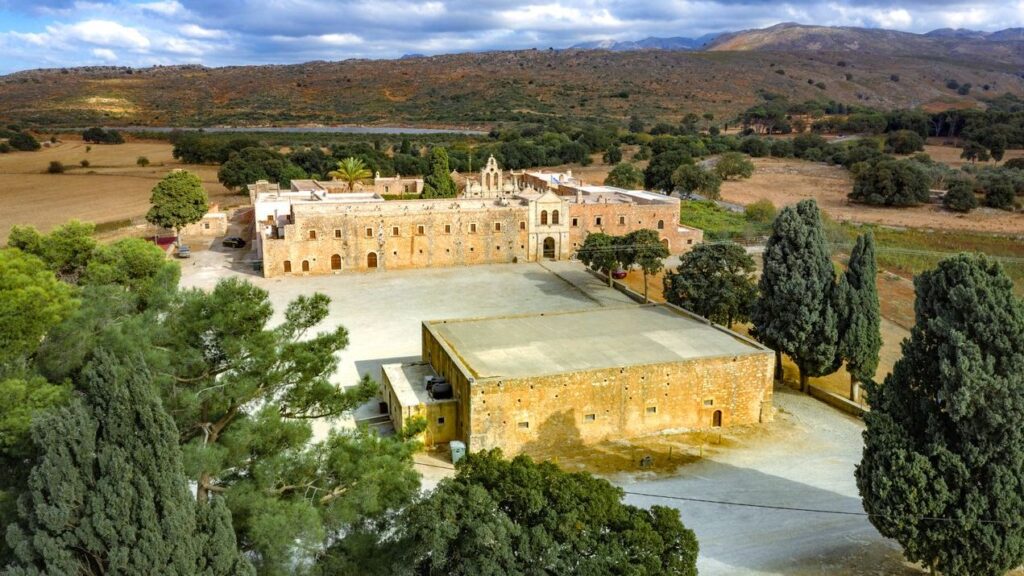Located in the southeast of Rethymno, Arkadi Monastery Crete Greece is one of the island’s most powerful historic landmarks. Apart from its stunning Renaissance façade and tranquil courtyards, the monastery has a tragic yet heroic history.
In this guide, we’ll explore the monastery’s historical significance, how to get there, what to see during your visit, visitation tips, nearby attractions to combine with your visit, and why it deserves a spot on your Crete itinerary.
What’s the historical significance of Arkadi Monastery?
Founded in the 11th century by a monk named Arkadios, Arkadi Monastery became an important spiritual and cultural centre. By the 16th century, under Venetian influence, the monastery grew, and its church was built in the Renaissance style. Manuscripts, religious art, and learning flourished during this time, making it the heart of Cretan Orthodox culture.
The monastery is best known for the 1866 Arkadi Holocaust. A defining moment in Crete’s fight for independence. During the Cretan Revolt against Ottoman rule, nearly 1,000 villagers sought refuge within its fortified walls.
When the 15,000 Ottoman troops attacked the monastery, the villagers refused to surrender. Instead, they ignited the gunpowder stores, sacrificing themselves rather than being captured.
Today, Arkadi is recognised as a national sanctuary and symbol of freedom. Annual commemorations are held on the 8th of November to honour those who perished.

How to get to the Arkadi Monastery Crete?
Located about 25 km southeast of Rethymno at an elevation of 500 meters, Arkadi Monastery is accessible by car, bus, or taxi.
Renting a car is the easiest option. The drive from Rethymno takes about 30 minutes. Along the way, you’ll enjoy scenic views of olive groves and valleys. If you prefer to take public transport, the public buses also run from Rethymno to Arkadi. A one-way ticket costs around €3. The journey lasts roughly 40 minutes. Lastly, you can also hire a private car or taxi. This option is much more convenient but also more expensive.
The best time to visit is in the spring and autumn due to the milder temperatures and fewer crowds. In summer, the afternoons get very hot, so planning your visit for early morning is the best choice.
What to see during your visit to the Monastery of Arkadi
The monastery has many sections for exploring.
At the heart of the monastery is the Katholikon, the main church built in 1587. Dedicated to the Transfiguration of Christ and Saints Constantine and Helen, it was built with Renaissance details and elegant bell towers. Nearby, the Powder Magazine holds a heavier story, as it was the site of the explosion of 1866. Its preserved walls still carry the weight of that tragic event. Don’t forget to explore the Refectory and Stables, where bullet and sword marks remain from the fierce battle.
Just outside the monastery walls is the Ossuary, a memorial that holds the bones of those who perished in the revolt. Finally, the Museum is a must-see during your visit, with manuscripts, icons, and relics that trace the monastery’s spiritual and historical journey.
Must-do checklist
- Admire the Renaissance façade of the church
- Visit the powder magazine and reflect on the 1866 sacrifice
- See the bullet marks in the refectory
- Pay respects at the ossuary
- Explore the small museum and its rare artefacts
- Take in the panoramic views of the surrounding plateau

Tips for visiting the Monastery
Arkadi Monastery is an active religious site, so respectful behaviour and dress are necessary.
Modest clothing is required, so be sure to cover your shoulders and knees. We suggest carrying a light scarf to cover up as you enter holy grounds throughout your travels in Greece.
Photography is welcome outdoors, but avoid using flash inside the church and museum. Keep your voice low, especially during services, and stay on marked paths to protect fragile areas.
The entrance fee is €3, and donations are welcome to help with preserving the site.
Nearby attractions to explore
Crete has many villages and natural wonders to explore. Here are our top picks for nearby attractions to the Arkadi Monastery:
Rethymno Old Town
Just 30 minutes from Arkadi, Rethymno Old Town is a maze of narrow Venetian alleyways filled with colourful houses, elegant fountains, and charming shops. You will see Ottoman-era mansions, Renaissance doorways, and the Fortezza fortress. Enjoy the cafés and tavernas that line the waterfront, making it a great place to end the day with dinner by the sea.
Margarites Village
A short drive from Arkadi, Margarites Village is known as the pottery capital of Crete. Local workshops produce traditional clay pots, decorative ceramics, and modern designs. Walking through the village, you’ll see colourful pottery displayed outside small shops and artisans at work.
Arkadi Gorge
For nature lovers, the Arkadi Gorge has many scenic trails surrounded by olive groves, wildflowers, and dramatic cliffs. The hike is moderately challenging; therefore, this is better suited for experienced hikers.
Psiloritis (Mount Ida)
At an impressive altitude of 2,456 meters, Psiloritis (Mount Ida) is the highest mountain in Crete and is full of mythology. According to legend, Zeus was raised in a cave here, making it an important site in Greek mythology. Today, the mountain is a hiker’s paradise, with trails that range from easy walks to challenging ascents.
Nearby Beaches
If you’d like to balance history with relaxation, several nearby beaches are within reach. Rethymno Beach offers long stretches of golden sand with plenty of amenities, while Plakias Beach is quieter, with crystal-clear waters ideal for swimming and snorkelling.

Why Arkadi Monastery is one of Crete’s key historic landmarks
Visiting Arkadi Monastery Crete is one of the best ways to explore the island’s religious history and culture. Combined with its tragic history, this is one of the most significant landmarks in Crete.
To truly experience the region, stay nearby with Oreo Travel accommodations. From a traditional villa or a seaside apartment, our properties make it easy to explore Arkadi Monastery and the surrounding areas of Rethymno.






